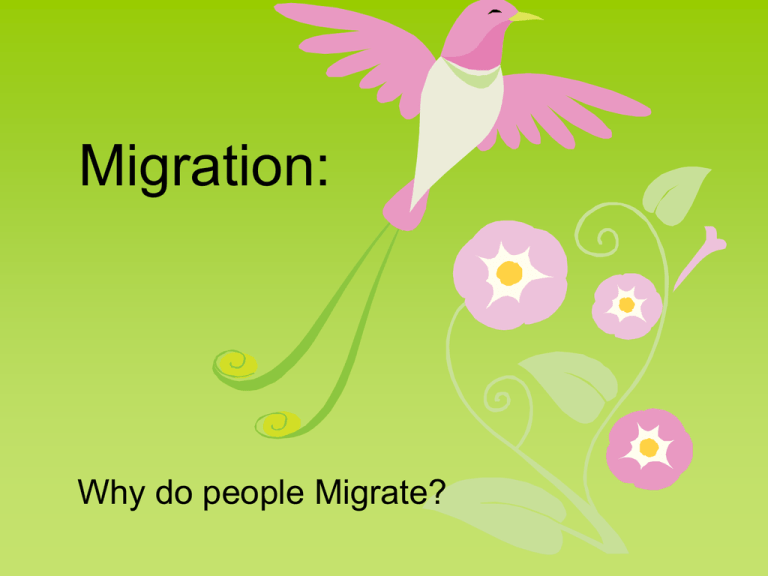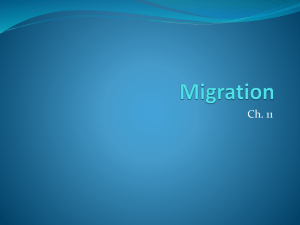1Why
advertisement

Migration: Why do people Migrate? Vocab • Cyclic Movement: movement that has a closed route and is repeated seasonally or annually – Nomadism: movement along a definite set of places • Activity Space: with in which daily activity occurs • Transhumance: a seasonal periodic movement of pastoralists and their livestock between highland and lowland pastures Vocab • Periodic Movement: movement that involves temporary, recurrent relocation, ex. Military, college students • Place Utility: the usefulness of a place • Space-Time Prism: A diagram of the volume of space and the length of time within which our activities are confined • Chain Migration: Migration of people to a specific location because relatives or member of the same nationality previously migrated there Ravenstein’s Laws of Migration (1889) 1. 2. 3. 4. 5. 6. 7. 8. Most migrants move only a short distance. There is a process of absorption, whereby people immediately surrounding a rapidly growing town move into it and the gaps they leave are filled by migrants from more distant areas, and so on until the attractive force [pull factors] is spent. There is a process of dispersion, which is the inverse of absorption. Each migration flow produces a compensating counter-flow. Long-distance migrants go to one of the great centers of commerce and industry. Additional Laws Natives of towns are less migratory than those from rural areas. males are more migratory than females. Economic factors are the main cause of migration. Ravensteins Laws -restated 1. Most migrants go only a short distance. 2. Longer-distance migration favors big city destinations. 3. Most migration proceeds step-by-step. 4. Most migration is rural to urban. 5. Each migration flow produces a counterflow. 6. Most migrants are adults. 7. Most international migrants are male. (Fellman 87) The Classic Stages Stage 1 Stage 2 Pre-Modern Industrializing /Urbanization Stage 3 Stage 4 Stage 5 Birth rate Natural increase Death rate 1929 by Warren Thompson Time Note: Natural increase is produced from the excess of births over deaths. www.prb.org Zelinsky’s Theory of Migration (1960s or 70s) • Phase one – (“Premodern traditional society”): – This is before the onset of the urbanization, and there is very little migration. – Natural increase rates are about zero. • Phase two – (“Early transitional society”): – There is “massive movement from countryside to cities... as a community experiences the process of modernization”. – There is “rapid rate of natural increase”. • Phase three – (“Late transitional society”): – This phase corresponds to the “critical rung...of the mobility transition” where urban-to-urban migration surpasses the rural to- urban migration, where rural-to-urban migration “continues Zelinsky’s Migration Theory (con’t) • Phase four – (“Advanced society”): – The “movement from countryside to city continues but is further reduced in absolute and relative terms, vigorous movement of migrants from city to city and within individual urban agglomerations...especially within a highly elaborated lattice of major and minor metropolises” is observed. – There is “slight to moderate rate of natural increase or none at all”. • Phase five – (“Future superadvanced society”): – “Nearly all residential migration may be of the interurban and intraurban variety….No plausible predictions of fertility behavior,... – a stable mortality pattern slightly below present levels”. 1. According to Wilbur Zelinsky’s theory of Migration Transition, A) a person living in a country that is in stage 1 of the Demographic Transition Model (DTM) is very unlikely to migrate internationally. B) a person living in a country that is in stage 2 of the Demographic Transition Model (DTM) is most likely to migrate internationally. C) a person living in a country that is in stage 3 or 4 of the Demographic Transition Model (DTM) is likely to migrate internally. D) all of the above. E) A and B only. Push/Pull Factors Everett Lee’s Push/Pull Theory (1960’s) Economic _______________ Few job opportunities ______________ Jobs are available Cultural _______________ Freedom; democracy ______________ Forced migration; slavery; political instability Environment ________________ Physically attractive ________________ Hazardous areas Gravity Model • Distance Decay – interaction between two places decreases as the distance increases. • Gravity Model – predicts the interaction between two bodies as a function of their size and distance Pa Pb I= Dab2 Migration to California Figure 4.6 (p. 95) Intervening Opportunity Model • aka Intervening Obstacles (can also be natural barriers) • • • • • • • • • • A-Ruby Tues. B-BK C-McD D-Cracker B E-Olive G. F-I-Hop G-Red Lob. H-Bleu I-Bojangles J-BK @HM Lee’s Push/Pull Model 2. The term “transhumance” refers to a. nomadic pastoralism that is seasonal b. slash and burn agriculture c. the movement of liquid in plants d. the movement of soil on a hillside e. the mobility of an advanced economic society 3. Which is a current intraregional migration trend in the United States? a. metropolitan to non metropolitan b. net emigration from the northeast c. urban to suburban d. rural to urban 4. Which of the following is not one of Ernst Ravenstein’s migration laws? a. The majority of immigrants move only a short distance. b. Migrants who move longer distances tend to choose cities as their destination. c. Each migration flow produces a counterflow. d. Families are less likely to make international moves than young, single adults. e. Push factors are usually more important than pull factors in explaining why people migrate. 5. Refugees migrate primarily because of which type of push factor? a. environmental b. circulation c. cultural d. economic 6. Which of the following events would be considered a migration pull factor? a. revolutionary takeover of a government b. flooding of a river c. opening of a new factory d. failed harvest 7. The most important pull factor for migrants to North America is a. economic b. political c. forced d. environmental 8. Which of the following is an effect of Chain Migration on the area of destination? A) Cultural homelands. B) Culture clusters. C) Multi-ethnic neighborhoods. D) Urban slums. E) Urban ethnic enclaves.






